Scientists Are Using Drones To Track These Critically Endangered Parrots
Could robots hold the key to saving Tasmania's vulnerable swift parrots?
Updated Nov. 15 2018, 5:08 p.m. ET
Swift parrots aren’t easy to track. These bright green birds don’t like to sit still, frequently hopping from tree to tree across the Tasmanian wilderness. And if you startle them, good luck catching up. The swift parrot is known for its fast flight speeds, clocking up to 55 mph.
But conservationists need to keep tabs on these critically endangered parrots, whose numbers have dwindled to less than 1,000 pairs. So they’re bringing in robotic assistance. Scientists believe drones can help them track and protect the remaining swift parrots in the wild, and they’re already seeing some success with this tech, according to a new study.
As Forbes reports, Australian researchers conducted eight trails to see if the drones could locate radio-tagged swift parrots. Six times, the drones estimated the bird’s coordinates within 164 feet of its true location. The robo aircrafts were quicker and more efficient than the human trackers in these experiments, losing sight of the target only twice. The results “provide validation” for drone wildlife tracking, the team concludes in the study, which was published last month in Science Robotics.
"Until now the tracking of wildlife has relied on researchers walking for hours on end with their arm in the air searching for the signal of one animal at a time before moving onto the next animal tag," Debbie Saunders, a co-author on the study, told ABC News.
"Wherever you can launch a drone, you can create a high point and maximize the chances of picking up that signal and search big areas very quickly."
Saunders believes the drones can provide critical information on the bird’s movements, information that is necessary to “revers[e] that decline.” The swift parrot’s current plight is partially due to sugar gliders, an invasive species that preys on the bird and its young. (Sugar gliders eat almost half of the female swift parrots that nest in Tasmania.)
But it’s also attributed to habitat loss. With the rise of logging in the bird’s native lands, the species has fewer places to call home. The decrease in trees has actually driven the parrots to suburban neighborhoods, where they stand a better chance at finding shelter.
"The only habitat that really remains is in the suburbs, because the habitat there has been developed for housing and recreation reserves and the like," Saunders explained to ABC News.
"So those big old trees in the suburbs really can be quite critical for endangered species, that's what they're reliant on."
Clearly, the swift parrot problem has a lot of wrinkles. But could the drone data inform a comprehensive new conservation strategy? The Tasmanian government would likely welcome new proposals, as their last idea — essentially, kill the sugar gliders — was met with controversy. But any new plans will require more funding, which Saunders believes is the crucial first step in stabilizing the swift parrot population.
"They're far from secure," she told ABC News. "In fact they are on a downward trajectory, but with the species' ability — they're a bit like a great Aussie battler if you like — they're incredibly resilient."
